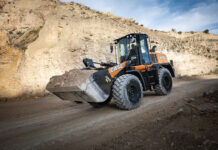Ralf Majchrzak, spokesperson for hydraulic attachments, Chicago Pneumatic Construction Equipment, explains how to get maximum longevity from a rig-mounted hydraulic breaker.
METICULOUS maintenance of a rig-mounted hydraulic breaker is extremely important in guaranteeing its longevity, which will positively impact a company’s bottom line.
After all, a rig-mounted breaker is no small investment and in today’s cost-conscious climate, it makes sense to protect that investment by ensuring the equipment operates effectively and efficiently over the long term. When it comes to caring for a rig-mounted breaker, the approach should be two-pronged:
1. Maximising performance through proper use in the field.
2. Setting up a hands-on preventative maintenance schedule.
In the Field
Correct use of a hydraulic breaker in everyday operation can ensure that repairs are minimised, and there are a few things that contractors can do to make sure they capitalise on their equipment investment. For instance, it’s not uncommon for some operators to use the tool on a breaker to pry concrete or rock into a better position. This is one of the worst practices an operator can engage in when it comes to keeping a breaker in optimal condition.
Using the hammer as a pry bar causes serious damage. As a result, the breaker can be damaged or the tool can be bend or break. Wrong positioning during the process can also cause unnecessary wear to important components.
Another important practice to follow in the field is to use a breaker only in short bursts. Running a breaker continuously for more than 15-30 seconds can cause extreme heat build-up and warp the tool, which ultimately decreases performance and productivity. Additionally, breaking is highly effective during the first 10 seconds and becomes very ineffective after 30 seconds, therefore to protect the machine regular repositioning is required.
Blank firing is a common mistake that can affect the longevity of a breaker. Blank firing occurs immediately after material is broken, and is basically the tool firing against itself since there is no material underneath.
If the force from that blow is not being absorbed by the rock or concrete, the breaker ends up absorbing the force. This can cause unnecessary wear to components, and as a result some manufacturers – like Chicago Pneumatic with its PowerStop mode – offer a feature on their breakers to reduce the occurrence of blank firing.
Establishing a Maintenance Plan
The second key process to ensure a rig-mounted hydraulic breaker has a long and productive life is to establish a proactive maintenance plan.
Lubrication is one of the most important means of maintaining a rig-mounted breaker, with a lack of proper lubrication directly correlating to a shorter overall lifespan. To help contractors protect their investment, leading manufacturers offer an automatic lubrication system. In the case of Chicago Pneumatic, a feature called CP-Lube is available for all RX breaker models from RX 14 and up.
After the first 50 hours, the carrier’s hydraulic filter should be inspected and changed, if necessary. Clean hydraulic oil is key to maximising the life of a breaker. At the 50-hour mark, it is also a good idea to perform a thorough check of the breaker, and make sure that all bolts are tightened to the required torque. During an inspection, it is also recommended for contractors to check the flow settings and adjust them, if needed.
A knowledgeable operator and a comprehensive maintenance plan go a long way to maximising the life of a rig-mounted hydraulic breaker. One practice without the other will not produce optimal results for the unit. It is the combination of proper use and care that will extend the life and ultimately benefit a contractor’s bottom line.













